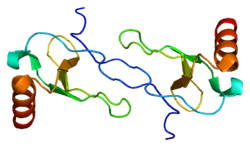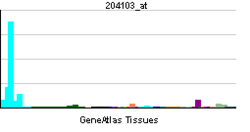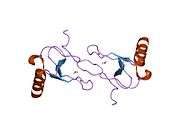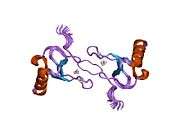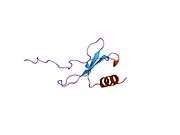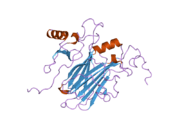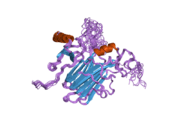CCL4
For carbon tetrachloride, with formula CCl4, see Carbon tetrachloride.
| View/Edit Human | View/Edit Mouse |
Chemokine (C-C motif) ligand 4, also known as CCL4, is a protein which in humans is encoded by the CCL4 gene.[3]
Function
CCL4, also known as Macrophage inflammatory protein-1β (MIP-1β) is a CC chemokine with specificity for CCR5 receptors. It is a chemoattractant for natural killer cells, monocytes and a variety of other immune cells.[4]
CCL4 is a major HIV-suppressive factor produced by CD8+ T cells.[5]
Perforin-low memory CD8+ T cells that normally synthesize MIP-1-beta.[6]
Interactions
CCL4 has been shown to interact with CCL3.[7]
See also
References
- ↑ "Human PubMed Reference:".
- ↑ "Mouse PubMed Reference:".
- ↑ Irving SG, Zipfel PF, Balke J, McBride OW, Morton CC, Burd PR, Siebenlist U, Kelly K (June 1990). "Two inflammatory mediator cytokine genes are closely linked and variably amplified on chromosome 17q". Nucleic Acids Res. 18 (11): 3261–70. doi:10.1093/nar/18.11.3261. PMC 330932
 . PMID 1972563.
. PMID 1972563. - ↑ Bystry RS, Aluvihare V, Welch KA, Kallikourdis M, Betz AG (December 2001). "B cells and professional APCs recruit regulatory T cells via CCL4". Nat. Immunol. 2 (12): 1126–32. doi:10.1038/ni735. PMID 11702067.
- ↑ Cocchi F, DeVico AL, Garzino-Demo A, Arya SK, Gallo RC, Lusso P (December 1995). "Identification of RANTES, MIP-1 alpha, and MIP-1 beta as the major HIV-suppressive factors produced by CD8+ T cells". Science. 270 (5243): 1811–5. doi:10.1126/science.270.5243.1811. PMID 8525373.
- ↑ Kamin-Lewis R, Abdelwahab SF, Trang C, Baker A, DeVico AL, Gallo RC, Lewis GK (July 2001). "Perforin-low memory CD8+ cells are the predominant T cells in normal humans that synthesize the β-chemokine macrophage inflammatory protein-1β". Proc. Natl. Acad. Sci. U.S.A. 98 (16): 9283–8. doi:10.1073/pnas.161298998. PMC 55412
 . PMID 11470920.
. PMID 11470920. - ↑ Guan, E; Wang J; Norcross M A (Apr 2001). "Identification of human macrophage inflammatory proteins 1alpha and 1beta as a native secreted heterodimer". J. Biol. Chem. United States. 276 (15): 12404–9. doi:10.1074/jbc.M006327200. ISSN 0021-9258. PMID 11278300.
Further reading
- Menten P, Wuyts A, Van Damme J (2002). "Macrophage inflammatory protein-1". Cytokine Growth Factor Rev. 13 (6): 455–81. doi:10.1016/S1359-6101(02)00045-X. PMID 12401480.
- Muthumani K, Desai BM, Hwang DS, et al. (2004). "HIV-1 Vpr and anti-inflammatory activity". DNA Cell Biol. 23 (4): 239–47. doi:10.1089/104454904773819824. PMID 15142381.
- Conti L, Fantuzzi L, Del Cornò M, et al. (2005). "Immunomodulatory effects of the HIV-1 gp120 protein on antigen presenting cells: implications for AIDS pathogenesis". Immunobiology. 209 (1–2): 99–115. doi:10.1016/j.imbio.2004.02.008. PMID 15481145.
- Joseph AM, Kumar M, Mitra D (2005). "Nef: "necessary and enforcing factor" in HIV infection". Curr. HIV Res. 3 (1): 87–94. doi:10.2174/1570162052773013. PMID 15638726.
- Zhao RY, Elder RT (2005). "Viral infections and cell cycle G2/M regulation". Cell Res. 15 (3): 143–9. doi:10.1038/sj.cr.7290279. PMID 15780175.
- Zhao RY, Bukrinsky M, Elder RT (2005). "HIV-1 viral protein R (Vpr) & host cellular responses". Indian J. Med. Res. 121 (4): 270–86. PMID 15817944.
- Li L, Li HS, Pauza CD, et al. (2006). "Roles of HIV-1 auxiliary proteins in viral pathogenesis and host-pathogen interactions". Cell Res. 15 (11–12): 923–34. doi:10.1038/sj.cr.7290370. PMID 16354571.
- King JE, Eugenin EA, Buckner CM, Berman JW (2006). "HIV tat and neurotoxicity". Microbes Infect. 8 (5): 1347–57. doi:10.1016/j.micinf.2005.11.014. PMID 16697675.
- Napolitano M, Modi WS, Cevario SJ, et al. (1991). "The gene encoding the Act-2 cytokine. Genomic structure, HTLV-I/Tax responsiveness of 5' upstream sequences, and chromosomal localization". J. Biol. Chem. 266 (26): 17531–6. PMID 1894635.
- Irving SG, Zipfel PF, Balke J, et al. (1990). "Two inflammatory mediator cytokine genes are closely linked and variably amplified on chromosome 17q". Nucleic Acids Res. 18 (11): 3261–70. doi:10.1093/nar/18.11.3261. PMC 330932
 . PMID 1972563.
. PMID 1972563. - Baixeras E, Roman-Roman S, Jitsukawa S, et al. (1991). "Cloning and expression of a lymphocyte activation gene (LAG-1)". Mol. Immunol. 27 (11): 1091–102. doi:10.1016/0161-5890(90)90097-J. PMID 2247088.
- Lipes MA, Napolitano M, Jeang KT, et al. (1989). "Identification, cloning, and characterization of an immune activation gene". Proc. Natl. Acad. Sci. U.S.A. 85 (24): 9704–8. doi:10.1073/pnas.85.24.9704. PMC 282843
 . PMID 2462251.
. PMID 2462251. - Brown KD, Zurawski SM, Mosmann TR, Zurawski G (1989). "A family of small inducible proteins secreted by leukocytes are members of a new superfamily that includes leukocyte and fibroblast-derived inflammatory agents, growth factors, and indicators of various activation processes". J. Immunol. 142 (2): 679–87. PMID 2521353.
- Zipfel PF, Balke J, Irving SG, et al. (1989). "Mitogenic activation of human T cells induces two closely related genes which share structural similarities with a new family of secreted factors". J. Immunol. 142 (5): 1582–90. PMID 2521882.
- Chang HC, Reinherz EL (1989). "Isolation and characterization of a cDNA encoding a putative cytokine which is induced by stimulation via the CD2 structure on human T lymphocytes". Eur. J. Immunol. 19 (6): 1045–51. doi:10.1002/eji.1830190614. PMID 2568930.
- Miller MD, Hata S, De Waal Malefyt R, Krangel MS (1989). "A novel polypeptide secreted by activated human T lymphocytes". J. Immunol. 143 (9): 2907–16. PMID 2809212.
- Adams MD, Kerlavage AR, Fleischmann RD, et al. (1995). "Initial assessment of human gene diversity and expression patterns based upon 83 million nucleotides of cDNA sequence" (PDF). Nature. 377 (6547 Suppl): 3–174. PMID 7566098.
- Post TW, Bozic CR, Rothenberg ME, et al. (1995). "Molecular characterization of two murine eosinophil beta chemokine receptors". J. Immunol. 155 (11): 5299–305. PMID 7594543.
- Combadiere C, Ahuja SK, Murphy PM (1995). "Cloning and functional expression of a human eosinophil CC chemokine receptor". J. Biol. Chem. 270 (28): 16491–4. doi:10.1074/jbc.270.28.16491. PMID 7622448.
- Paolini JF, Willard D, Consler T, et al. (1994). "The chemokines IL-8, monocyte chemoattractant protein-1, and I-309 are monomers at physiologically relevant concentrations". J. Immunol. 153 (6): 2704–17. PMID 8077676.
This article is issued from Wikipedia - version of the 6/6/2016. The text is available under the Creative Commons Attribution/Share Alike but additional terms may apply for the media files.
